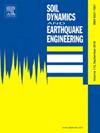Experimental and empirical shear modulus reduction curves for a wide range of strains
IF 4.6
2区 工程技术
Q1 ENGINEERING, GEOLOGICAL
引用次数: 0
Abstract
Understanding the shear modulus reduction behavior of soils under varying strain levels is vital for predicting soil response during seismic events. This study investigates the shear modulus reduction of diverse soil types using combined resonant column and cyclic triaxial tests. A single specimen is employed for both small and large strain ranges, which differs from conventional approaches that utilize two separate specimens. The shear modulus is assessed using different elastic moduli (E1, E′1, E2, and E3) within the stress-strain hysteresis loop, considering both compressional and extensional cyclic loadings. Results show significant deviation in secant moduli (G1, G′1, G2, and G3), varying from less than 20 % at small strains to 25–130 % at large strains, with hysteretic behavior becoming more asymmetrical at higher shear strains. Confining pressure (CP), relative density (RD), and coefficient of uniformity (CU) are identified as critical factors influencing modulus reduction. A two-parameter model was developed to accurately capture the strain-dependent normalized shear modulus behavior. Parameter ‘a’ is found to be independent of RD, CP, and CU, while reference strain ‘γref’ shows a strong dependency on confining pressure with an indeterminate relationship with relative density. Poorly graded soils exhibit higher stiffness with greater ‘γref’ values. The newly proposed mean, upper and lower bound curves can predict normalized shear modulus up to 10 % shear strains, significantly enhancing predictive capabilities beyond the typical 1 % strain limits of existing models. This improvement provides a more accurate basis for seismic response analysis, particularly in regions with similar soil types.
实验和经验剪切模量减少曲线为广泛的应变
了解不同应变水平下土壤的剪切模量降低行为对于预测地震事件中的土壤响应至关重要。本研究采用共振柱和循环三轴试验相结合的方法,研究了不同类型土壤的剪切模量减小情况。在小应变和大应变范围内均采用单一试样,这与使用两个独立试样的传统方法不同。在应力-应变滞后环中使用不同的弹性模量(E1、E′1、E2 和 E3)评估剪切模量,同时考虑压缩和伸展循环载荷。结果表明,秒模量(G1、G′1、G2 和 G3)存在明显偏差,小应变时小于 20%,大应变时为 25-130%,剪切应变越大,滞后行为越不对称。封闭压力(CP)、相对密度(RD)和均匀系数(CU)被认为是影响模量降低的关键因素。为准确捕捉随应变变化的归一化剪切模量行为,开发了一个双参数模型。发现参数 "a "与 RD、CP 和 CU 无关,而参考应变 "γref "则与封闭压力密切相关,与相对密度的关系不确定。劣质土壤的 "γref "值越大,刚度越大。新提出的平均值、上限和下限曲线可以预测高达 10 % 剪切应变的归一化剪切模量,大大提高了预测能力,超过了现有模型典型的 1 % 应变限制。这一改进为地震响应分析提供了更准确的基础,尤其是在土壤类型相似的地区。
本文章由计算机程序翻译,如有差异,请以英文原文为准。
求助全文
约1分钟内获得全文
求助全文
来源期刊

Soil Dynamics and Earthquake Engineering
工程技术-地球科学综合
CiteScore
7.50
自引率
15.00%
发文量
446
审稿时长
8 months
期刊介绍:
The journal aims to encourage and enhance the role of mechanics and other disciplines as they relate to earthquake engineering by providing opportunities for the publication of the work of applied mathematicians, engineers and other applied scientists involved in solving problems closely related to the field of earthquake engineering and geotechnical earthquake engineering.
Emphasis is placed on new concepts and techniques, but case histories will also be published if they enhance the presentation and understanding of new technical concepts.
 求助内容:
求助内容: 应助结果提醒方式:
应助结果提醒方式:


